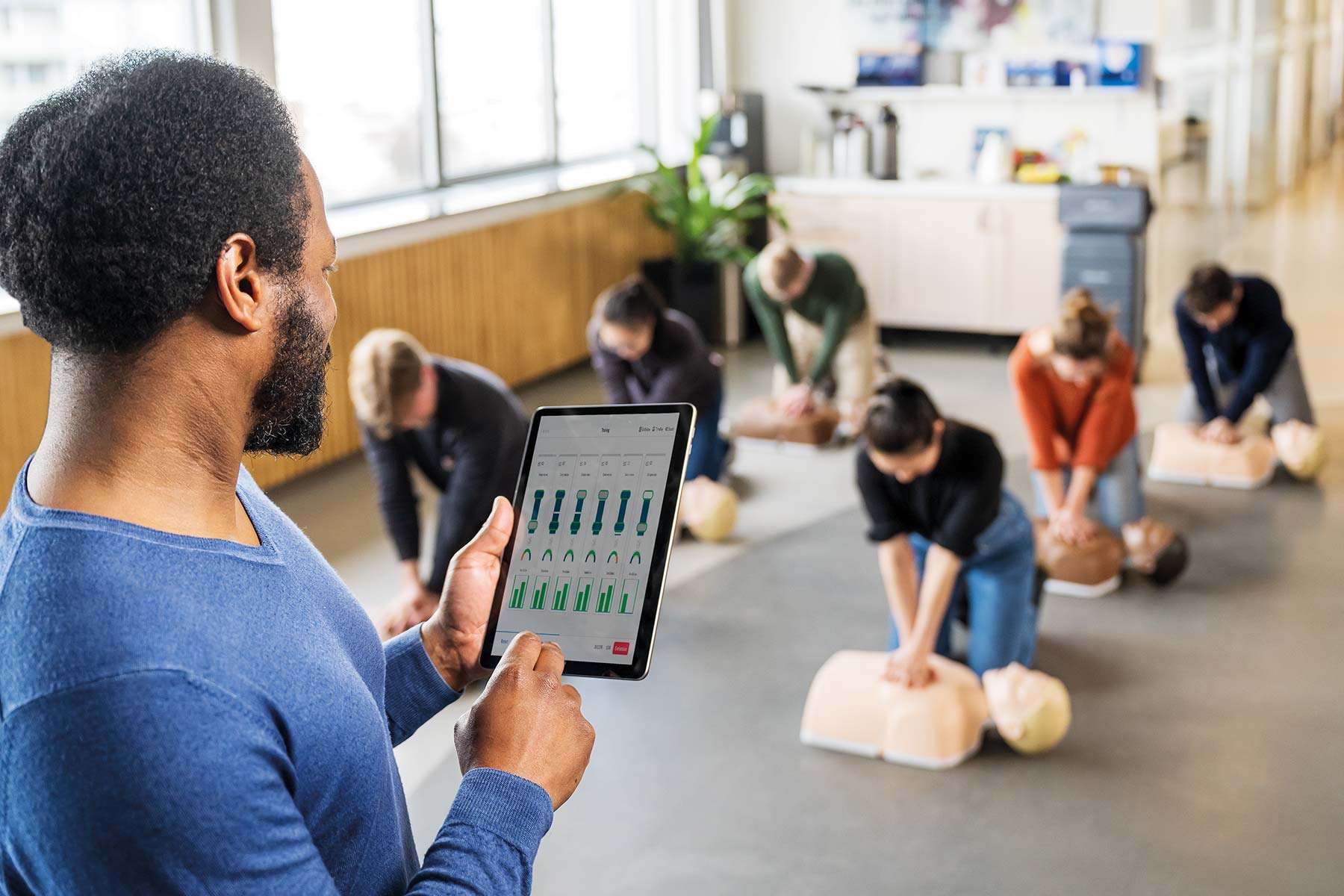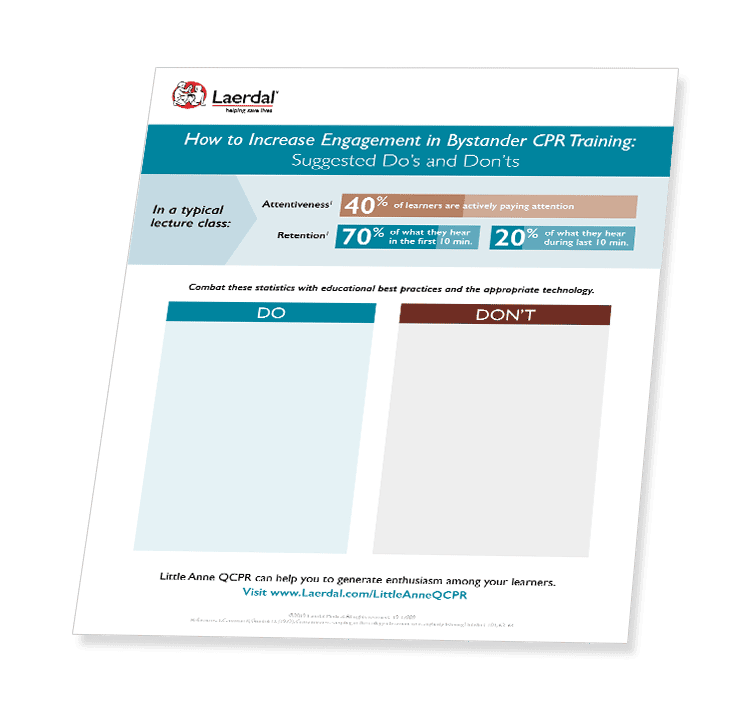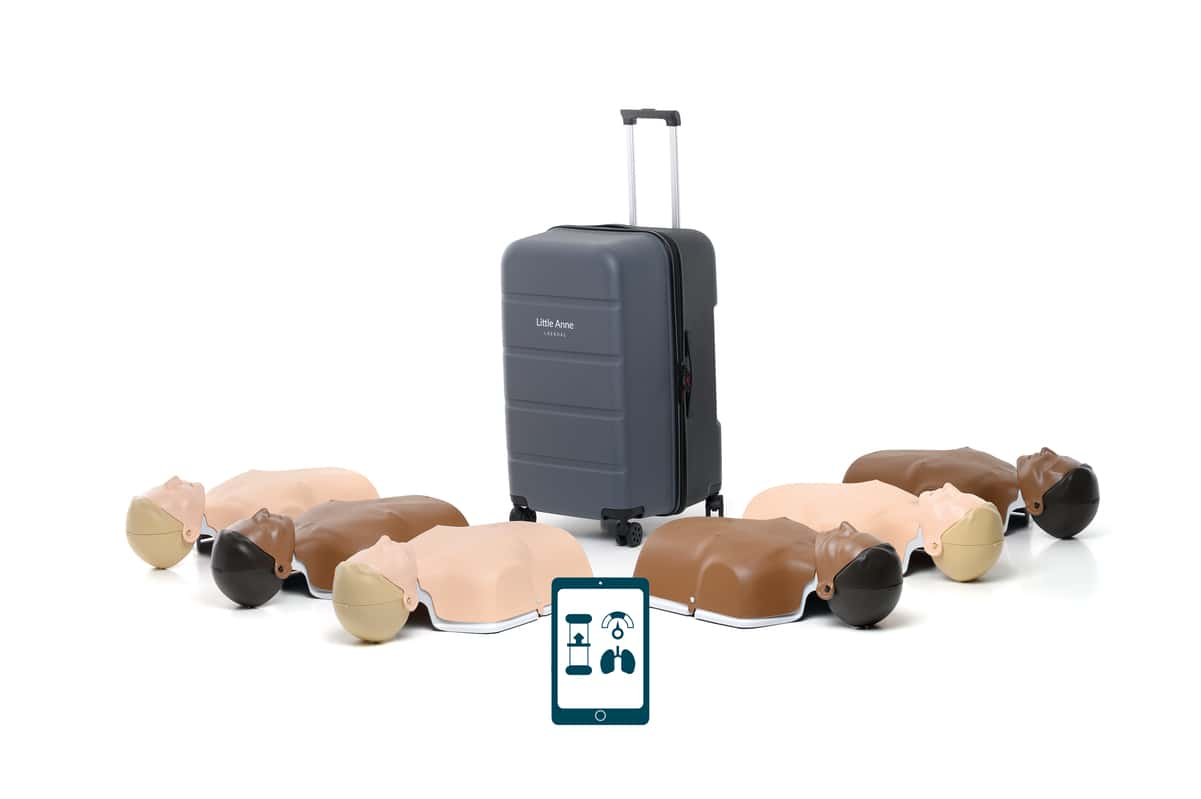4 Spørsmål som avgjør om din HLR-trening er effektiv
Hvordan bruke Kirkpatrick-modellen i ditt HLR-treningsprogram?
Å engasjere studenter er en grunnleggende utfordring i enhver form for utdanning, spesielt når studenten er nybegynner eller oppfrisker sine ferdigheter. Hvis du er instruktør i hjerte- og lungeredning (HLR), har du sannsynligvis opplevd vanskeligheter med å holde folk engasjert - spesielt når du underviser lekfolk.
Lekfolk som lærer HLR for første gang, blir ofte overrasket over den strukturerte treningsplanen som er nødvendig for å lære en klinisk ferdighet. De er ikke forberedt på den teoretiske opplæringen som er involvert; i stedet forventer de å gå rett til å øve kompresjoner på en dukke. Utfordringen for mange instruktører er at når studentene møter denne strukturerte tilnærmingen, kan de miste interessen. De kan begynne å fokusere bare på å bestå testen. Men vil de forlate kurset med selvtillit til å utføre HLR senere? Og hvordan vil de prestere når det virkelig gjelder?
En av de mest utprøvde og testede modellene for å måle opplæringseffektivitet er Kirkpatrick-modellen. Denne modellen, som har vært betrodd av pedagoger i flere tiår, kan hjelpe deg med å identifisere muligheter for engasjement ved å besvare fire enkle, men målrettede spørsmål.
Nedenfor skisserer vi hvordan du kan anvende denne modellen på din opplæring og oppnå engasjement i hver klasse.
1. Hvordan reagerer dine elever på HLR-opplæringen?
I følge Kirkpatrick-modellen er det viktig å vurdere hver students reaksjon på materialet slik at du bedre kan identifisere hva de trenger for å holde seg aktive i læringsprosessen.1 I følge Kirkpatrick-modellen er det viktig å vurdere hver students reaksjon på materialet slik at du bedre kan identifisere hva de trenger for å holde seg aktive i læringsprosessen
For å øke engasjementet blant elevene i kurset ditt, kan du vurdere å inkludere gamification, altså bruk av spillrelaterte prinsipper i læring, det er en populær metode for å motivere elever til å delta aktivt.2
Noen dokumenterte fordeler:
- Studenter får en økt følelse av eierskap over egen læring
- Mer moro i klasserommet
- Mer synlig sporing av studentenes læringsprogresjon.3
Forskning har vist at selv leger nå bruker online videospill som et læringsverktøy. Dette gjør det mulig for dem å lære nødvendig informasjon på kortere tid, samtidig som de konkurrerer mot andre leger.4 Bruken av gamification i helsevesenet viser at det har anvendelser for å lære livredningsteknikker, og HLR-opplæring er intet unntak.
Konkurranse kan ha stor innvirkning i klasserommet. Dagens HLR-tilbakemeldingsteknologi kan naturlig legge til rette for denne typen konkurranse, noe som kan gjøre læringsopplevelsen både mer engasjerende og effektiv.

QCPR App
En app som lar deg kontrollere og få tilbakemeldinger fra QCPR-treningsdukker og AED-trenere. Få den QCPR-tilbakemeldingen du kjenner og elsker, nå både forenklet og utvidet. Forbedre debriefingen med omfattende rapportering for instruktører, og tilby en enestående treningsopplevelse for både samfunns- og profesjonelle brukere.
2. Hvordan måler du hva elevene dine har lært og ikke har lært?
Etter å ha adressert studentengasjement, anbefaler Kirkpatrick-modellen at du flytter fokuset til hvor mye studentene faktisk har lært. Forlater studentene kurset med kunnskap om når og hvordan de skal utføre effektiv HLR? For å kunne gi et omfattende svar på dette, kan det være nødvendig å måle kvaliteten på hver students HLR mer nøyaktig.
Med dagens teknologi for treningsdukker kan du måle brystkompresjonsfraksjon, hastighet, dybde og tilbakeslag, samt ventilasjoner. Dette gjør det mulig å vise studentene nøyaktig hvordan deres prestasjoner samsvarer med innholdet du har lært dem. Slik kan du sikre at de forstår og kan anvende teknikkene riktig.
American Heart Association (AHA) sine retningslinjer fra 2020 lister opp viktige målinger som er knyttet til bedre overlevelse.:5
- Brystkompresjonsfraksjon (CCF): minst 60%
- Brystkompresjonshastighet: 100–120 kompresjoner per minutt
- Brystkompresjonsdybde: 5-6 cm for en gjennomsnittlig voksen
- Unngå å lene deg på brystet mellom kompresjonene for å tillate fullstendig tilbakeslag av brystet
- Ventilasjon: nok til å produsere synlig heving av brystet
I tillegg er det verdt å vurdere hvor sannsynlig det er at studentene dine vil trene andre eller fortsette å øve på sine HLR-ferdigheter. 70 % av amerikanere føler seg hjelpeløse under en nødsituasjon fordi de enten ikke vet hvordan de skal utføre HLR, eller fordi det er lenge siden de har trent. Å forstå hva plutselig hjertestans er, vite hva man skal gjøre, og få nøyaktige tilbakemeldinger og korrigeringer under praktisk øvelse kan oppmuntre flere til å handle hvis og når det trengs.
3. Hvor godt anvender elevene dine HLR-opplæringen sin?
Tredje nivå av Kirkpatrick-modellen anbefaler spesifikt å vurdere atferdsendring etter opplæring. Vil dine elever utføre HLR på et offer for plutselig hjertestans?
Forskning viser at mange tilskuere forblir passive når de står overfor en nødsituasjon. Kun 46% av hjertestansofre mottar HLR fra en tilskuer.7
En studie utført av American Heart Association undersøkte nærmere hvorfor de fleste velger å ikke gripe inn.8 Respondentene oppga flere årsaker, inkludert:
"Å overvinne de psykologiske barrierene av frykt og fornektelse kan bety at mange flere liv potensielt kan bli reddet. Noe HLR er bedre enn ingen HLR"9
Dr. Rob Rosenbaum, emergency doctor with Christiana Care Health System and EMS director for New Castle County, Delaware
For instruktører betyr dette å legge større vekt på å øke elevenes selvtillit. I stedet for bare å forstå mekanikken bak god HLR, oppnår studentene selvtillit gjennom repetitiv praksis, nøyaktig tilbakemelding på prestasjoner og forsterkning av riktig teknikk.
4. Oppnår du den effekten du ønsker?
Når du vurderer resulatene av opplæringen din, er antallet liv som reddes den viktigste målingen. Hvert og et halvt minutt får noen i USA hjertestans utenfor sykehus.10 Fire av frem ganger skjer hjertestans hjemme11 og ofte med med venner og familie til stede.
Som HLR-instruktør har du en unik mulighet til å forberede dine elever på å redde liv. Ved å benytte de mest engasjerende opplæringsmetodene, fremme positive holdninger og utstyre dem med de nødvendige verktøyene, kan du sikre at studentene forlater klassen din like inspirerte som da de kom inn.
Er lavt engasjement i klasserommet en utfordring?
Føler du at elevene dine forlater HLR-opplæringsprogrammet mindre inspirerte enn da de kom inn? Bruk disse tipsene for å fange og holde på elevenes oppmerksomhet.

Vil bidra til å gjøre HLR-treningen mer effektivt

Referanser
- American Red Cross. (2017). CPR training. Retrieved from http://www.redcross.org/take-a-class/cpr/cpr-training
- Learning Theories. (2016). Gamification in education. Retrieved from https://www.learning-theories.com/gamification-in-education. html
- Ibid
- Patten, B. (2015). How health care can benefit from gamification. Training Industry, Inc. https://www.trainingindustry.com/e-learning/ articles/how-health-care-can-benefit-from-gamification.aspx
- American Heart Association. (2020). 2020 American Heart Association Guidelines for Cardiopulmonary Resuscitation and Emergency Cardiovascular Care, Part 3: Adult Basic and Advanced Life Support. Circulation, 142:S366–S468. DOI: https://doi.org/10.1161/CIR.0000000000000916
- American Heart Association. (2014). CPR Statistics. Retrieved from http://www.heart.org/HEARTORG/CPRAndECC/Whatis%20 CPR/CPRFactsandStats/CPR-Statistics_UCM_307542_Article.jsp#.WZLwxlWGOUl
- American Heart Association. (2017). 2017 hands-only cpr fact sheet. Retrieved from http://cpr.heart.org/idc/groups/ahaeccpublic/@wcm/@ecc/documents/downloadable/ucm_493890.pdf
- American Heart Association News. (2017). Most americans afraid to perform cpr. Retrieved from http://news.heart.org/manyamericans-afraid-to-perform-cpr/
- Haelle, T. (2015). Bystander cpr doubles cardiac arrest survival rates. Everyday Health. Retrieved from http://www.everydayhealth. com/news/bystander-cpr-doubles-cardiac-arrest-survival-rates/
- Ibid
- American Heart Association. (2017). See reference #7.